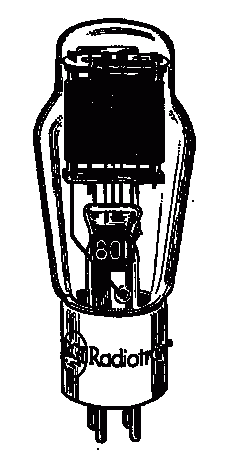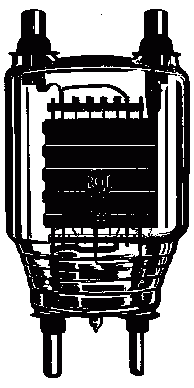There was a time when vacuum tubes were your only choice if you wanted electrical amplification or rectification. They went into radios, televisions, amplifiers, cars, airplanes, computers, sex toys, broadcasting equipment, tanks (F#%KING TANKS), and a whole bunch of other common household items. Because of this, there was (and still is) a metric shit-ton of tube types out there. The vast majority of them are no longer manufactured, but there are still factories pumping out a pretty good variety. We are not even going to scratch the surface, so here is a half-ass list of the tube types you’ll probably run into at some point if you’re playing with tube audio.
Triode
Triodes are the most basic amplification tube. They have three electrodes: anode, cathode, and grid. Many audio geeks swear by triodes for just about every possible application because of their pleasing harmonic distortion profile and low plate resistance. Triodes are also generally easy to work with and design around.
Triodes are extremely common for small signal (preamp and input) use, but are harder to find for power and output duty. Many common small signal triode tubes have two identical triodes in the same envelope (glass bulb); this is useful for stereo audio (2 channels) and other interesting topologies like the SRPP, Mu-Follower, Aikido, and so on. Directly Heated Triodes (DHTs) use the cathode itself as the heater and are highly regarded for audio, though the direct heating of the cathode can complicate the design optimization process. Everyone gets a big ear boner over a nice 300B (directly heated power triode) amplifier.

Pentode
Pentodes were developed after triodes to provide more gain (amplification) and less distortion. In addition to the triode’s anode, cathode, and grid, pentodes have a screen grid and a suppressor grid. These two extra grids exist to lessen the effects of the electrons that fart around and play bumper cars around the tube instead of being attracted to the anode. More efficient use of the electrons is generally a good thing.
Some people prefer the sound of triodes, even though pentodes have several advantages on paper. At some point, a clever tube MacGyver discovered that you can nullify the effects of the extra pentode grids in a pentode tube in order to make it operate like a triode. This is called triode-strapping and it is a common way to create a power triode (because power triodes are usually either rare, directly heated, or expensive).

Beam Power Tetrode
Sneaky effer RCA produced and popularized beam power tetrodes because Philips/Mullard owned the patent rights to pentodes. Beam power tetrodes have a anode, cathode, grid, screen grid, and an electron beam-forming plate instead of the pentode’s suppressor grid. The electron beam-forming plate sounds way more badass, but the two types of tubes are pretty similar. Like pentodes, beam-power tetrodes can generally be triode-strapped to create a frankentriode.

Rectifier
A rectifier tube converts the AC (Alternating Current) electricity from your power transformer to the DC (Direct Current) electricity that tubes use. It is usually found in the power supply section of a tube amp and is technically a diode (twin diodes usually). Diodes don’t have a grid, so the electricity flows freely from cathode to anode. Various models of rectifier tube reduce your high voltage by different amounts due to their internal resistance. This is actually very handy for small adjustments to your voltage, but rectifier tubes are much more temperamental than their solid state equivalents. Some people prefer the effect tube rectification has on an amplifier; others say it shouldn’t matter in an ideal power supply.
Tube Sockets
All of these types of tubes come in different sizes and shapes, and with different numbers and arrangements of pins (AKA “pinout”). The tube pins themselves can have various sizes and physical relations to one another, and so there are many different types of sockets to allow tubes to plug into equipment. And, of course, the same socket probably has more than one name. Because f*%k making sh!t easy, I guess.
- Octal (AKA 8 pin) – medium base; common for power pentodes and beam power tetrodes like KT88, EL34, 6V6, etc; also common for older dual triodes like 6SN7, 6SL7, etc
- Noval (AKA 9 pin mini) – small base; common for small pentodes like EL84, EF86, etc; also common for small dual triodes like 12AU7, 12AT7, 6DJ8, etc
- UX4 (AKA 4 pin) – large base; common for DHT tubes like 300B, 2A3, 45, etc
- Loctal (AKA Loktal) – medium base; similar to octal but the tube “locks” into place; originally designed for use where equipment is subject to vibration (cars, sex toys, etc)
- Heptal (AKA 7 pin mini) – small base; similar in size to noval; common for tubes like 6AQ5, 6AU6, etc
- Compactron (AKA 12 pin) – medium base; badass name for a tube socket; common for dual pentode and triple triode tubes
Heater Ratings and Equivalents
Some tubes are available with the same electrodes (anode, cathode, grids), but different heater ratings. Remember that all the heater does is warm up the cathode so that it shits out electrons. The 6BQ5 (a common small power pentode) is an example of one of these tubes with heater doppelgangers. The 10BQ5 is the same tube but with 10.6V heaters instead of 6.3V. The two types of tubes, as far as performance is concerned, are identical.
You can put a 10BQ5 in a design for 6BQ5 as long as you provide it with the correct heater voltage/current. If you look at the data sheets for these tubes, you’ll see that the wattage in the heaters is the same. The 6BQ5’s heaters need 6.3 volts at .76 amps, or about 4.77 watts (W = V * I). The 10BQ5’s heaters need 10.6 volts at .45 amps, also 4.77 watts. The heaters in both tubes suck up the same amount of power in order to make heat for the cathode. If you try to run a 10BQ5 at 6.3V though, it probably won’t work. If you try to run a 6BQ5 at 10.6Vs, it will probably blow shit up.
And if that didn’t blow your gourd, the EL84 is a direct equivalent to the 6BQ5. So is the N709. So is the CV2975. You can probably stick a 7189 in most 6BQ5 designs. Or a 6P14P. All these different designators came about from different brands (Mullard, RCA, GE) or because they had different original purposes (longer life, military usage, etc).




